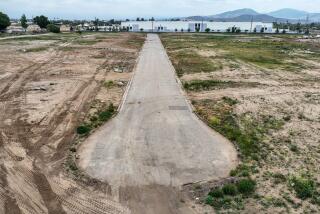Calabasas Cityhood Bid Falters Again : 3 Residential Areas, Industrial Park Omitted; New Finance Study Ordered
- Share via
The wobbly Calabasas incorporation campaign stumbled once more Wednesday as three residential areas and an industrial park were dropped from the proposed city’s boundaries--and a new challenge to the city’s financial stability was raised.
The Los Angeles County Local Agency Formation Commission eliminated about three square miles from the western edge of the proposed city after developers complained that incorporation might jeopardize their plans.
Commissioners also delayed until Feb. 10 a decision on the incorporation request so a third economic feasibility study can be conducted.
The setbacks disappointed cityhood backers, who have struggled for 2 1/2 years to overcome county skepticism about incorporating the sparsely developed ranchland west of the San Fernando Valley.
Supporters had managed to beat back several challenges to their application. They conducted their own analysis of tax revenues to overturn a projected deficit and successfully pushed for a special state law to save millions of dollars in brush-fire protection costs.
On Wednesday, they sidestepped another threat by convincing LAFCO not to exclude a 1,300-acre tract. The ranchland, earmarked for development by the Irvine-based Baldwin Co., separates eastern and western Calabasas.
Over the bitter objections of Baldwin manager James Harter, who called the action potentially damaging to his 1,500-home project, commissioners agreed to keep the land within the city.
Dozen Owners Excluded
But the panel voted to exclude a dozen owners of smaller parcels in a move that dropped the industrial park and three neighborhoods.
The action left cityhood backers with an irregularly shaped area of about 11 square miles and about 20,000 residents. The proposed municipality is bounded by Woodland Hills on the east and Las Virgenes Road on the west--although it jogs west of the road to include a car dealership.
Left out was the 199-space Woodland Park Mobile Estates on Topanga Canyon Boulevard at the eastern edge of the proposed city. The park’s residents had heavily supported incorporation.
Also dropped was the 250-house Saratoga Hills neighborhood at the western edge of Calabasas, north of the Ventura Freeway at Lost Hills Road. A newly developing 1,500-home area south of the freeway and west of Las Virgenes Road was also excluded.
“I’m very disappointed,” said Norman Buehring, a longtime Saratoga Hills resident who led the cityhood campaign in his neighborhood. “We’re going to be an isolated island. We wanted to be a part of the larger community.”
Loss of the industrial park, south of the Saratoga Hills area, was decried by cityhood committee members, who had counted on tax revenues from its businesses to help pay for municipal services.
Committee treasurer Marvin Lopata said his group will undertake a new budget study to parallel one ordered by LAFCO for the February hearing.
Depending upon the findings, more land could be removed or added to the proposed boundaries at that hearing, said commission chairman Kenneth I. Chappell.
“If our figures can support us, we’re in,” Lopata said. “But I’m not so sure they can. We’re losing a lot of revenues here.”
Committee chairman Robert Hill tried to be more upbeat after the four-hour Los Angeles hearing, attended by about 300 Calabasas residents.
“We’re very confident about the figures. We’re over $1 million in surplus,” Hill said.
One commission member publicly disputed that, however.
Pete Schabarum, county Board of Supervisors representative to the panel, charged that the Calabasas budget faces a first-year deficit because the brush-fire protection law that the city expects to benefit from is invalid.
The law, authored by state Sen. Ed Davis (R-Chatsworth), limits the amount the county Fire Department can charge the new city for brush-fire protection. Gov. George Deukmejian’s signing of the law in August erased a projected first-year budget deficit of $236,763.
Schabarum, who is feuding with Davis because the senator accused him of meddling in the recent Santa Clarita cityhood election, said Davis’ measure conflicts with a law prohibiting the “gift” of public funds and another requiring cities to reimburse counties for services such as fire protection.
Assistant County Counsel Bill Pellman, who said he discovered the conflict when preparing county service contracts for the new City of Santa Clarita, said the state constitution also prohibits agencies making “gifts” of public funds to other government entities.
Late Wednesday, however, the legality of Davis’ measure was defended by Charlie Fennessey, his Sacramento legal coordinator.
He said the reimbursement law cited by Schabarum and Pellman apparently applies only to cities that otherwise would receive “free” county services after incorporation due to the July-to-June fiscal calendar used by the county.
More to Read
Sign up for Essential California
The most important California stories and recommendations in your inbox every morning.
You may occasionally receive promotional content from the Los Angeles Times.











